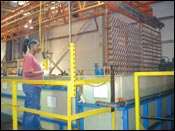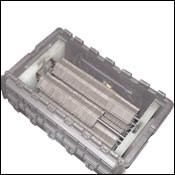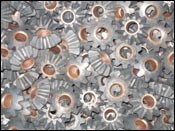Beyond Quality Systems
KC Jones defines quality by value added for customers
#masking
Those of us of a certain age remember a not-too-distant past when ISO 9001 certification was a big deal. Companies even trumpeted the announcements of their registration to the quality system standard with advertisements. Quality consultants made a lot of money helping manufacturers prepare for and pass audits.
Oh, how times have changed.
Featured Content
“These days, quality and delivery are just the price of entry,” says Brian Harrick, corporate quality manager, KC Jones Plating Co. (Warren, MI). “It’s taken for granted that you’re ISO certified, and that you can turn parts around quickly on a just-in-time basis.”
KC Jones operates three plants in Warren; Hazel Park, MI; and Columbia City, IN. The company’s 35,000 sq ft Hazel Park plant is devoted mainly to high-volume rack and barrel plating of a variety of automotive components using zinc alloys, hex-free chromates, and proprietary electroless nickel and bronze plating processes. Workers in a 30,000 sq ft facility in Warren apply adhesives and sealants to fasteners and other parts, while the 30,000 sq ft Indiana plant does plating and electropolishing for mostly non-automotive customers. All told, the company employs about 100 people.
“Of course, we are ISO 9001-2000 certified,” Harrick continues. “When we got certified, we really already had those quality systems in place. The certification just made it official. It really didn’t impact our business very much.”
So, if a functioning quality system and the ability to consistently deliver on schedule are taken for granted, what does quality mean?
Design Involvement
“What we try to do is be more proactive, to be more involved in part design,” Harrick says. We get a lot of RFQs that say plate to spec. So engineers at a supplier or automaker will specify a coating, and if you follow the print and you have a failure, everyone circles the wagons.
“It’s just no good to continue down that path,” Harrick says. “We’d much prefer to work with the customer, understand the part function, and work from there. As metal finishers—and I think this applies to all metal finishers—we need to work more closely with design engineers to try to make sure a part is going to work the way they need it to work.
“Our ideal situation is, we sit down with the customer and find out what they really need,” he continues. “Where are the problems? What do they really need the part to do? We take the part, go into our lab, and determine what the best coating is and develop the process. Ideally, our customers will allow us to do a bit of engineering work and become more of a partner. So it’s not so much getting a print and plating to spec, it’s more what are you doing to minimize quality and warranty issues for your customers.”
A good example of how a bit of plating knowledge can prevent a potentially major headache is a fuel filter canister that KC Jones processes for a Big Three automaker. The part sits directly inside the vehicle’s gas tank, where it’s constantly exposed to fuel.
“The design engineer specified a zinc alloy coating for that part,” recalls Hazel Park plant manager Marty Hartrick. “But there was no way we could throw zinc alloy electroplate down to the bottom of the canister at a production level of 10,000 pieces per day. Even worse, the part might be exposed to ethanol in a flexible-fuel vehicle. Ethanol and water make sulfuric acid, so the part would’ve lasted about five minutes with a zinc alloy coating.
“When we called the engineer, it turned out electroless nickel was on the list of approved finishes, but it cost a little more money,” he recalls. “We convinced them to change the finish to electroless nickel.”
An example of how plating to print spec can lead to trouble is provided by another part, a transmission fluid fitting. The specification calls for 0.003 in of zinc nickel plating, and getting the required coating thickness in a deep bore was causing excessive thickness on other areas of the part as well as a rough microfinish in the bore that was hampering installation of a rubber O-ring at the customer’s plant. “The customer told us their other supplier didn’t have the problem of roughness in the bore,” Hartrick recalls. “When we looked at some of their parts, we found out they were using a different coating than we were. I told our customer that, and the response was: ‘Oh. Well, maybe that’s what we want, then.’”
Transmission Pinion Gears
A happier story is a forged and hobbed steel transmission pinion gear that KC Jones processes for a Big Three customer at the rate of 30,000 pieces per day. The company plates a nominal thickness of 0.0012 in of its proprietary Miccrolloy bronze on the part inside diameter to provide wear resistance with a separate bearing or bushing.
The high-speed, low-tin plating solution is custom blended for KC Jones, and the process required a lot of development to enable consistent plating of that volume of parts every day. “The deposit needs to a very even thickness of bronze, and only the part ID can be plated,” Hartrick explains. “It’s really the racking that ensures a smooth, even coating on the part ID and lets us run those big volumes. We currently process 30,000 parts a day over two shifts. Before we re-engineered the process, it used to be a challenge running 18,000 pieces over three shifts.
The process initially used dual rectifiers with copper and tin anodes. The new process has no anodes—everything’s done by addition—and uses a single rectifier for each of four cells. Each rack contains 468 parts.
Quality assurance on the components starts with computerized process monitoring. The software shows conditions in each cell. “We isolate each cell to make sure there are no stray currents, shorts, loss of power, or any other problems,” Harrick says. “So we can control the process to a point that we can see actual plating in real time, because it was critical that each part had the correct coating thickness.”
Workers check thickness on a single part from each cell. If it’s OK, the rest of the parts in the cell are assumed to be OK. “But, if we find a part that’s not right, we check the entire cell,” Hartrick says. “Then we use the software to help us go back and troubleshoot the problem.”
KC Jones workers also perform 100% plug gaging of the ID on parts after they come out of a drying oven. “The customer hones the ID, and they need a 100% functional part,” Hartrick explains. “The only thing that matters to them is that the differential pin fits in that ID. So this check is really for them. Our internal check is one part per cell, but our check for them is 100% inspection.”
More Proprietary Plating
KC Jones’s Hazel Park plant also operates a proprietary nickel boron electroless process that provides high hardness and wear resistance at a cost not much higher than conventional electroless nickel, according to Hartrick. “Every chemical supplier has a nickel boron chemistry, but we have one that’s made only for us,” he explains. “It works with rack or barrel processes. It was developed by another company, and we basically bought the chemistry and developed and refined it for production.”
Experimentation with the process began in KC Jones’s lab, then moved to a 100-gal tank after a couple of months. “We had to change he equipment and change the chemistry to make it work as we scaled it up,” Hartrick says.
“Now we’ve got it down now to regular additions based on square footage going through the process. We can run about 2 sq ft/gal in a 500-gal tank. The price premium for our Ni-B over conventional electroless nickel is only about 10%,” he adds.
One part benefiting from the hard electroless nickel coating is a thrust washer for a Big Three transmission application.
“The customer has multiple thrust washers that we process,” Hartrick explains. “Some are steel, some are bronze, some are coated with Teflon on one side. We’re working with them now to simplify coatings on a whole range of washers and give them as good or better performance than they’re getting now at a lower price.”
“We’ve been supplying these washers for 20 years,” Harrick adds. “In that time, transmissions have changed—parts are subject to higher torques, transmissions have more speeds, there’s more emphasis on fuel economy—and we acknowledge that maybe our parts aren’t lasting as long as they once did. So we met with the customer and they explained what their best-practice part was that they had tested.
“We said, ‘OK, we can make it out of a cheaper base metal, we can plate it differently, we can put a top coat on it, and we can do it for the same price that you’re paying now for the current part,” he says.
According to Harrick, switching to a nickel boron electroless plated thrust washer also allowed sourcing of the raw part from a wider variety of suppliers and eliminated potential assembly errors arising from incorrect part orientation. “The old washer had to be oriented for assembly,” he explains. “By eliminating the need to orient the parts, feed them one way, have an operator watch them, we provided automatic mistake-proofing during assembly. That has a large value, to be able to eliminate those potential problems.”
Assuring quality on the thrust washers during processing is one thing, but the nature of the parts also required development of some special packaging. The parts get 0.0004 in of the nickel boron coating, which has hardness of >70 RC. The bronze substrate is very soft, so one potential problem is cracking or flaking of the coating.
Multiple Dimensions of Quality
“The parts being so soft also means we can’t ship them in bulk,” Hartrick says. “Instead, we developed some special shipping containers. We stack the washers on a rod in the correct orientation, then the rods lock into place in a special container we developed with our customer. At the customer plant, the operators takes the rod, places it on the machine, pulls the cotter pin, and the machine is loaded. And, the customer knows there’s always the same number of parts per tote.”
Another aspect of quality that’s often taken for granted—at least until there’s a problem—is waste treatment. At Hazel Park, the waste treatment system consists of four separate tanks, one for each of the plant’s main plating processes. Waste treatment includes a cyanide destruct system, foam reduction, and precipitation of heavy metals. “All waste streams are segregated, treated according to which process it came from, and adjusted for pH,” Hartrick says.
Waste treatment is an area where good documentation can be important, according to Harrick. “Whenever there’s a problem with wastewater here in the city, they usually come to us first,” he says. “The city people come through, check our records, and keep on moving. So it’s important to have those systems in place not only to handle the waste treatment but to be able to document your waste treatment.”
KC Jones also operates a full lab to monitor its processes and wastewater. The lab includes full process development capability with a full-time lab manager, full-time chemist, and the usual array of equipment for coating thickness measurement and composition analysis. It also contains some relatively sophisticated equipment that may not be found in just any plating company, including atomic absorption and inductively coupled plasma spectrometers that are used for both process and wastewater analysis.
The Bottom Line
The drive by automakers to push more and more functions down to their supply base has been going on for years, but Harrick believes there’s still a bit of a disconnect when it comes to coating specification. “We’ve worked on jobs where we did everything to print, but parts failed. We’re always the last ones to touch the parts, so basically we’re always at fault. It doesn’t matter that maybe it was a design problem.
“It’s tough to push back against that, so we’ve developed in-house systems to try to deal with it,” he says. “When we get an RFQ, we sit down as a team to review the print and the coating requirements, trying to understand the component and envision any potential pitfalls down the road. Then we try to draw the customer in to the process, and get them to allow us to add our expertise when it comes to the finishing.”
RELATED CONTENT
-
Cleaning, Pretreatment to Meet Medical Specs ISO 13485 or FDA 21 CFR820
Maximilian Kessler from SurTec explains new practices for industrial parts cleaning, metal pretreatment and decorative electroplating in the medical device industry.
-
Blackening of Ferrous Metals
The reasons for installing an in-house cold blackening system are many and varied.
-
Masking for Surface Finishing
Masking is employed in most any metal finishing operation where only a specifically defined area of the surface of a part must be exposed to a process. Conversely, masking may be employed on a surface where treatment is either not required or must be avoided. This article covers the many aspects of masking for metal finishing, including applications, methods and the various types of masking employed.





















